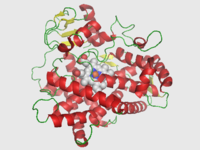
Photo from wikipedia
The potent hERG channel blocking drug ondansetron is used off-label for treatment of nausea and vomiting in early pregnancy. Some human epidemiological studies have associated ondansetron with fetal cardiovascular defects… Click to show full abstract
The potent hERG channel blocking drug ondansetron is used off-label for treatment of nausea and vomiting in early pregnancy. Some human epidemiological studies have associated ondansetron with fetal cardiovascular defects and orofacial clefts. This study investigated the effects of ondanestron on embryonic heart rhythm of gestational day (GD) 13 rat embryos in vitro and then integrated the results with published animal teratology, and animal and human pharmacokinetic studies to perform a risk evaluation. Ondansetron caused concentration dependent bradycardia and arrhythmia. Cardiovascular malformations in rats occurred at exposures slightly higher than those in early human pregnancy. Together the results suggest that ondansetron can have teratogenic potential in rats and humans mediated via hERG block and severe heart rhythm disturbances in the embryo. The risk may be increased in human pregnancy if additional risk factors are present such as hypokalemia.
Journal Title: Reproductive toxicology
Year Published: 2018
Link to full text (if available)
Share on Social Media: Sign Up to like & get
recommendations!